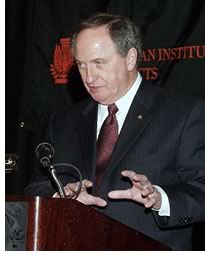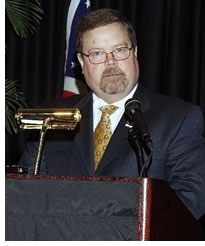

03/2005
 AIA
Executive Vice President/CEO Norman L. Koonce, FAIA, delivered the preliminary
2004 Annual Report to Grassroots attendees February 11, 2005. “Considering
what to share in my final CEO’s Perspective for an AIA Grassroots
Leadership and Legislative Conference has been difficult,” said
Koonce. “Clearly it has been a privilege for me to serve this profession,
the Institute, and you in the role of CEO for these six-plus years. While
there have been extraordinary challenges during that time, I have found
them to be equally energizing and the results rewarding. I have been
inspired by a plaque in my office—given by a special friend—that bears
the inscription, ‘Nothing nurtures success like a steadiness of
purpose.’”
AIA
Executive Vice President/CEO Norman L. Koonce, FAIA, delivered the preliminary
2004 Annual Report to Grassroots attendees February 11, 2005. “Considering
what to share in my final CEO’s Perspective for an AIA Grassroots
Leadership and Legislative Conference has been difficult,” said
Koonce. “Clearly it has been a privilege for me to serve this profession,
the Institute, and you in the role of CEO for these six-plus years. While
there have been extraordinary challenges during that time, I have found
them to be equally energizing and the results rewarding. I have been
inspired by a plaque in my office—given by a special friend—that bears
the inscription, ‘Nothing nurtures success like a steadiness of
purpose.’”
Before summarizing the list of AIA accomplishments in 2004, Koonce praised the AIA national staff, calling them “exceptional individuals who are not only capable and qualified, they are dedicated professionals. They are faithfully committed to serving the components and our more-than 75,000 members. We refer to each other as the AIA family, and that’s a genuine expression of how we feel.” He also thanked the component executives for “doing the work of many. We salute them for their extraordinary resourcefulness and capacity for consistently providing complex, thoughtful, responsive solutions to the membership.” Koonce continued, “It also has been a privilege to work with the elected volunteer leaders of AIA. I hold in high esteem their vision, integrity, dedication, diligence, and commitment to continuity.”
Strengthened strategic plan
“Much has been said about the AIA Strategic Plan. And rightly so.
Several years ago, the Strategic Plan encompassed 48 strategies and was
referred to by some as an ‘unfunded mandate from the national component’ with
little application beyond the Beltway,” said Koonce. “Today
it is a succinct nine-page document, including the cover and three appendices,
that describes in straightforward language what the Institute is committed
to accomplishing. Not only does it guide the work of the national component,
an increasing number of state and local components are using the four strategies
to guide their own planning efforts. Each interprets the document within
the context of their own, unique needs and initiatives, moving us closer
to becoming ‘One AIA.’”
Accomplishments in 2004
Drawing from the preliminary annual report, Koonce noted that the AIA’s
return to solvency has allowed the organization to “change from
a reactive to a creative state of mind.” That change in thinking
is already reaping rewards. Highlights from successes in 2004 include:
- Government Advocacy invested in people and other resources to increase its successes. According to the Annual Report, The GA team “successfully lobbied for four legislative issues during the last seven months of the 108th Congress: passage of Brightfields demonstration project; protection of the 10 percent historic rehabilitation tax credit; passage of the $358 million tax cut for architects and engineers; and extension of the tax cut to all architecture and engineering firms, not just C corporations.”
- The Public Advocacy team produced the most successful and largest AIA National Convention and Expo in history. In fact, Koonce said, the AIA must now begin to manage growth of the convention to maintain the highest quality for educational programs and exhibitions. Additional successes for the PA team include the launch of a redesigned and more functional AIA Web site and increased AIArchitect readership of more than 20 percent.
- Last year saw the re-creation of the Center for Communities by Design. At the beginning of 2004, the CxD was unstaffed and of uncertain future. Today, it is a thriving resource for community design issues and includes oversight of important and far-reaching initiatives such as the AIA’s Design Assistance Team (DAT), Regional/Urban Design Assistance Team (R/UDAT), and the AIA disaster assistance program. Following the December 26, 2004, tsunami that devastated Southeast Asia, the CxD coordinated the AIA’s response, including creating a Web page directing donors to reputable relief organizations, sending condolence letters with offers of help to the architecture associations in the affected nations, and summit meetings with representatives from 19 collateral design and construction organizations to communicate and coordinate tsunami-relief plans.
- The new Board Knowledge Committee was created in 2004 to nurture Knowledge Team initiatives and information-sharing. The committee will enhance the focus of the Knowledge Team and foster opportunities for creating, sharing, and applying critical knowledge.
- Sales of contract documents have exceeded projections by 64 percent, resulting in revenue-sharing with state and local components of nearly $3 million. Our current electronic format is receiving great reviews, and more and more licenses are being issued to a broad spectrum of users. This success is the result of implementation of a comprehensive strategic plan for documents nearly three years ago, and investment of $4.5 million during that time.
Koonce noted that in 2001, the Institute faced a serious crisis—the dire financial situation that affected the security and future of the AIA. Through sound fiscal management and a lot of hard decisions, “we prevailed, and words cannot express our pride at meeting the challenge. The Institute is now in excellent financial condition,” said Koonce.
 A return to sound footing
A return to sound footing
AIA Treasurer James A. Gatsch, FAIA, provided attendees with an unaudited
overview of the current financial outlook for AIA. During the financial
crisis, AIA leadership created a plan to ensure the future health and
security of the Institute. That plan called for the AIA’s total
net assets to equal 20 percent of annual budgeted revenue by 2007.
Gatsch reported that that goal has now been met—three years ahead
of schedule. At the end of 2003, net assets totaled $5.2 million, with
investments equaling $8.4 million. The unaudited 2004 net assets are
$9.7 million, with investments totaling $23.7 million. In addition,
Gatsch reported that the AIA did not use its line of credit during
2004.
And the good news continues: for every $1 of increased dues revenue, non-dues revenue was augmented $16. The AIA Finance and Audit Committee, however, is already considering the effect of a decrease in dues revenue in 2008, when the temporary dues increase recently adopted for the advertising program expires.
Looking ahead
Returning to the lectern, Koonce turned his attention to the future challenges
and opportunities facing our profession and the Institute. Alerting
the members to a significant issue with which the profession is already
confronted, he summarized discussions that have been ongoing among
all stakeholders in the building design and construction industry.
Excessive change orders, cost increases, and completion delays have
been attributed in recent years to inadequate documentation by architects
and engineers. Numerous industry task group discussions revealed that
a primary cause of these problems rest not only in the documentation,
but, to a very large extent, in the timing, accuracy, and dependability
of shared knowledge concerning project outcomes. The exploration of
these issues was driven by large-owner groups, such as the Construction
Users Roundtable (CURT), and the U.S. General Services Administration.
The integrated practice models that have evolved include far broader
and more complete sharing of project knowledge even before detailed
design is commenced, reliance on three-dimensional virtual models for
design presentations, and extending it to four-dimensional virtual
models for construction documentation. This provides all parties the
opportunity to evaluate the manner in which risk and rewards are shared. “We
have the opportunity to drive this train or be run over by it,” Koonce
said.
Koonce also discussed the promising connection between architecture and neuroscience, a new area of study that has the potential for dramatically enhancing how and why the design of our physical environment affects the quality of our lives. With a commitment to research from our profession, we will one day design with the benefit of evidence-based decisions about the application of the elements and principles of architecture. He also called for a “commitment to the next generation of professionals through the creation of practice academies and teaching firms,” correlating the practice of training architects to that of doctors in teaching hospitals. Pilot program models already have been established.
Koonce concluded his remarks by calling for the coming together of the AIA local, state, regional, and national components as “One AIA—accepting our shared responsibility for the growth and development of the profession.” That commitment, he continued, will be expressed, “in ways that resonate and respond to the unique circumstances of each community and component.” All of the AIA must seek collaboration opportunities with all other components on important issues, initiatives, and resources, enriching both experience and outcome.
“Let me close by saying that as I look out across this room, I see the faces of many friends: some I have known for years and others I have just met. I also see over 700 people who understand what it means to be a responsible person in today’s society, and who are capable of acting on that understanding,” he continued. “Leadership is serving, and serving requires a servant mentality. Leadership isn’t easy, but the rewards are worth the effort.” Koonce ended with a quotation from one of his favorite books by Dr. Seuss, Oh the Places You’ll Go (Random House, 1990):
 You’ll
get mixed up, of course
You’ll
get mixed up, of course
As you already know.
You’ll get mixed up
With many strange birds as you go.
So be sure when you step,
Step with care and great tact
And remember that Life’s
A Great Balancing Act.
Just never forget to be dexterous and deft.
And never mix up your right foot with your left.
And will you succeed?
Yes! You will, indeed!
(98 and 3/4 percent guaranteed.)
So . . . be your name Buxbaum or Bixby or Bray
Or Mordecai Ali Van Allen O’Shea,
You’re off to great places!
Today is your day!
Your mountain is waiting.
So . . . get on your way.
“HAVE A GREAT JOURNEY!” Koonce wished the audience.
The audience responded with a standing ovation.
Copyright 2005 The American Institute of Architects.
All rights reserved. Home Page ![]()
![]()
 |
||
|
||